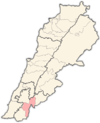|
Al-Khiyam
Al-Khiyam (Arabic: الخيام; sometimes spelled Khiam) is a large town and municipality in the Nabatieh Governorate of Southern Lebanon. EtymologyAccording to Edward Henry Palmer, the name means tents.[2] Haifa Nassar, a Khiyam-based journalist, cites sources that confirm this. Muhammad Qubaisi, author of a book on South Lebanon, writes that according to the Torah, Jacob moved his family and livestock to the plain of Al-Khiam, where he lived in tents.[3] LocationAl-Khiyam is situated approximately 100 kilometres (62 mi) south from the capital city of Beirut and 35 kilometres (22 mi) south-east from the city of Nabatieh. The border with Israel is 5 kilometres (3 mi) to the south. Khiam lies at a height of 800 metres (2,625 ft) above sea level. HistoryOttoman periodIn 1596, the village of Hiyam was an Ottoman nahiya (subdistrict) of Tibnin under the liwa' (district) of Safad, with a population of 111 Muslim households and 7 bachelors. The villagers paid a tax on wheat, barley, olive trees, vineyards, goats and beehives, in addition to "occasional revenues"; a total of 6,914 akçe.[4][5] In 1838, Eli Smith writes about el-Khiyam'," a Metawileh, "Greek" Christian and Maronite village in Merj 'Ayun'.[6] In 1875, Victor Guérin visited: "El Khiam contains two quarters: the one on the south, with a population of 700 Metawileh, and the other on the north, with 600 Christians, divided into Maronites, Greek-Orthodox, and Greek-Catholics, with some Protestants, who have founded a chapel and a school."[7] In 1881, the PEF's Survey of Western Palestine (SWP) described it as: "A village, northeast of the Merj Ayun, built of stone, containing about 300 Christians and 200 Druze. It contains a white round Moslem holy place and a modern church. It is situated on a low ridge, surrounded by figs, olives, and arable. The water supply is from three rock-cut cisterns, one birket, and the good spring of 'Ain ed Derdarah."[8] French mandate periodThe municipality of Al-Khiyam was established in 1928 during the French Mandate.The first municipal council, led by Haj Mohammad Haj Hussein Abdullah, was dissolved in 1931. In 1935, Haj Ali Afandi Haj Ibrahim Abdullah was elected mayor. In 1937, he stepped down after being appointed to the Lebanese parliament. [9] After independenceIn 1953, Haj Khalil Haidar was re-elected and served as mayor until 1957. In 1957, he was replaced by Hassan Ali Faiz who remained in this position until 1963. A new council was elected in 1963, with 16 members, and Kamel Mohammad Ali Al-Daoui as the mayor and Haj Asaad Khalil Mhana as the deputy mayor. This council continued its work until the outbreak of the Lebanese Civil War in 1975.[10] During the 1990s, Al-Khiam was the site of the Khiam Detention Center, operated by the South Lebanon Army during the Israeli occupation of Southern Lebanon. Lebanese Muslim civilians were exposed to torture by Israeli and Lebanese agents in this camp and faced indefinite detention once arrested.[11] The prison was captured by Hezbollah during the Battle of Khiam in 2000, shortly before the Israeli withdrawal from South Lebanon. The town saw a major confrontation between the Israeli Army and Hezbollah fighters in the 2006 Lebanon War, during which a United Nations post was bombed by the Israeli Army killing four United Nations Military Observers.[12] The IDF and Hezbollah clashed in the area once again in June 2024, with fighter jets and artillery strikes.[13][14] In October 2024, the village of Al-Khiyam become the site of heavy fighting between the IDF and Hezbollah. On 29 October, Israeli tanks entered the outskirts of the Khaim, marking their deepest push into southern Lebanon since launching a ground operation in September.[15] DemographicsIn 2014 Muslims made up 93.17% and Christians 6.48% of registered voters in Al-Khiyam. 91.29% of the voters were Shiite Muslims.[16] Notable people
References
Bibliography
External links
|
||||||||||||||||||||||||||||||


